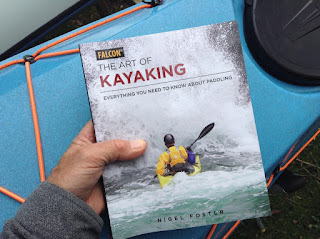 |
| Photos provided by Nigel Foster |
By Outside Adventure to the Max Guest Blogger Nigel Foster
My mantra is to achieve the greatest effect with the minimum effort. I find efficiency seductive but to best achieve this I need to start again with the basics. Efficient paddling makes use of the body’s most powerful muscle groups to do the bulk of the work powering the kayak, with good posture ensuring the most effective alignment for performance.I also try to maximize the traction from my paddle in the water so I can power forward or make smooth turns without wasting energy. I want to make my kayak move forward; I don’t want to use my energy to move water.
 |
| Edging in a turn, the blade here is in neutral |
Basic science can explain why in some kayaks it doesn’t seem to make any difference whether you edge into a turn or edge away from it, both seem equally effective, while in some other kayaks you can clearly turn more quickly when edged into a turn, or in others most quickly when edged from a turn.
It will also explain why you can turn some kayaks more rapidly while reversing than when you are paddling forward.
It’s a good idea to hone the effectiveness of your paddling skills on flat water where you can focus on mastering the details even if your normal playground is far from flat. It is easier to compare the effect of every nuance once you eliminate the variables of wind, current and waves. With control strokes, begin with the blade close to or in a neutral position, engaging the blade gradually and only as much as you need.
 |
| The blade is lightly engaged for steering |
When you understand how to get the most effective performance from your kayak in wind alone, or in waves or current alone, then the next step is to combine them, wind and waves together, or all three.
 |
| Work on your efficiency in different conditions |
I’ll leave you with three questions. Revisit one of them when you next paddle.
1) Can I improve the efficiency of my body movement for power? For example, can I use my torso more and my arms less? Am I using my legs and feet?
2) How much do I move water with my paddle, and when do I do this most? Can I reduce this, maybe by slowing my paddle stroke a little, or by adjusting the path of my paddle?
3) Am I working against the waves, wind, and current, or working with? If I can identify a particular situation when I have to work harder than I would like, can I find a way to use less effort in this situation?
My new book The Art of Kayaking offers a lot of detail for the inquisitive paddler, explained in a way that is easy to understand. It describes in detail the basic paddle and kayak skills, and then focuses their use toward different rough-water environments. The goal is to achieve more effect with less effort. You’ll also find help for trip planning with weather, charts, buoy age and safety.
Find The Art of Kayaking at store.nigelkayaks.com, (there is a signed copy option) Or support your local bookstore, or order on-line, perhaps at Amazon or Book Depository.
Nigel Foster is an English sea kayaker, kayak designer, instructor and author. His other books with FalconGuides include On Polar Tides, and Paddling Southern Florida. Foster presently lives in Seattle, WA with his wife Kristin Nelson. You can contact him through his web-site at www.nigelkayaks.com.
Outside Adventure to the Max is always looking for guest bloggers. Contact us at Nickayak@gmail.com if you are interested.
Nigel Foster is an English sea kayaker, kayak designer, instructor and author. His other books with FalconGuides include On Polar Tides, and Paddling Southern Florida. Foster presently lives in Seattle, WA with his wife Kristin Nelson. You can contact him through his web-site at www.nigelkayaks.com.
Outside Adventure to the Max is always looking for guest bloggers. Contact us at Nickayak@gmail.com if you are interested.



